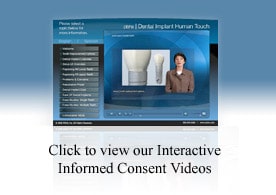Removal of a tooth is one of the most common procedures performed by an oral and maxillofacial surgeon. Reasons for tooth removal may include :
- Advanced tooth decay
- Severe periodontal disease
- Teeth involved with cysts/tumors
- Impaction (inability to erupt)
The following is a discussion of the more commonly performed dental-related surgeries by Dr. Sultan.

What Is An Impacted Tooth?
When a tooth is "stuck" in the gum or bone and is prevented from erupting, it is considered "impacted". The most common impacted tooth is the third molar, or "wisdom tooth". Because of human development and dietary habits, most people do not have enough room in the jaws for all 32 teeth. Hence, the wisdom teeth, or the most posterior teeth in the mouth become impacted. However, other teeth are also commonly found impacted, such as the canine, second bicuspid, and second molar.
Impacted wisdom teeth can cause problems, although they may not cause symptoms. Developing impacted teeth may cause crowding of other teeth, necessitating braces. Partially erupted teeth may cause inflammation and infection in the surrounding gum and bone. The soft tissue sac of the developing impacted tooth may enlarge into a fluid-filled cavity or cyst. Localized growths can occur in association with impacted teeth, or tumors.
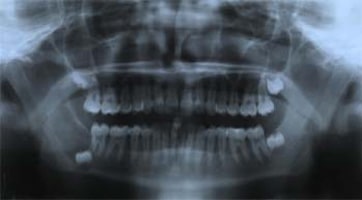
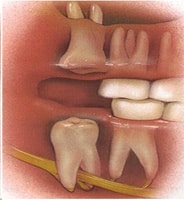
It is extremely important for Dr. Sultan to obtain a 3-dimensional image (Cone Beam CT) of the jaws in order to evaluate for any of these conditions. The advantage of the CT over a conventional panoramic image is the ability to determine the exact anatomic location of the teeth in question to important structures (i.e. nerves, sinus). This information is vital to determining the risk of the surgery and to help avoid complications. As healing takes place more easily in the younger patient, removal of impacted teeth is recommended prior to age 25 if possible. However, it is not uncommon to remove an impacted tooth on an adult patient wearing dentures! Thus, the reasons for a thorough periodic exam by your dentist with an appropriate referral is important.
A more in-depth discussion on impacted teeth can be found in the audio/visual section of this site or within the following multimedia presentation.
Who Is A Candidate For Impacted Wisdom Tooth Removal?
The removal of wisdom teeth is basically one of the pleasantries of being a teen, right up there with acne. That’s when the wisdom teeth descend and become trapped behind gum tissue and other teeth. Your regular dentist will keep an eye on your wisdom teeth. They show up in x-rays and their path is charted as they begin to descend. When the time is right for extraction, your dentist will refer you to an expert oral surgeon, such as Dr. Sultan.
In most cases, waiting to extract them isn’t a good idea. They may take all the way until age 25 to erupt, but just their presence next to other molars can cause problems. The best plan is to proactively remove them. Why? When a teenager is between the ages of 15 and 18 his or her wisdom tooth roots are only two-thirds formed, making this the perfect time to extract them. Wait until their 20s and extraction will become more involved. If you think your teen will be one of the few whose wisdom teeth will descend, take their place as another set of molars, and not cause crowding or worse problems with his or her bite, that’s not the reality of the vast majority of people.
Exposure of Impacted Teeth
Should an impacted tooth be required in the arches to restore a normal bite relationship, your orthodontist may recommend exposure of the tooth. This is a common procedure for many impacted teeth, except the wisdom teeth.
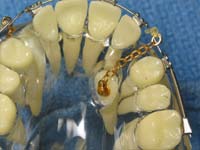
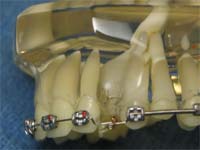
Through a small incision, the impacted tooth is uncovered, freed, and an orthodontic bracket attached. The tooth is then gradually brought into position by the orthodontic appliances.
Tooth Removal In Preparation for Dentures
Due to severe disease, unrestorable teeth may be removed in preparation for placement of a partial or complete denture. Teeth can be removed individually or all at once. In conjunction with tooth removal, recontouring of the surrounding bone (alveoplasty) is performed in order to allow unrestricted placement of the appliance.
We can get away with our tailbone and appendix, but the arrival of our wisdom teeth is invariably bad news. If we still had longer jaws everything would be fine, but our modern shorter jaw length means there isn’t any room for the third set of molars. So, when your wisdom teeth come down, they become impacted (blocked) by the other teeth. They can come in sideways, pushing on the adjacent teeth. They sometimes are surrounded by bone. Often one wisdom tooth will partially erupt, creating pockets in the gums that are perfect places for bacteria to thrive.
Although you may know someone who has their erupted wisdom teeth in place, people like that are very, very rare. Others seem to never have had their wisdom teeth come down and cause havoc. Those few are evolutionarily advanced! For the rest of us, the wisdom teeth simply cause the other teeth to be pushed out of position. This impacts our overall bite and can create more dental problems. That’s why wisdom teeth need to be removed.
You return home after your surgery with Dr. Sultan. Depending on the degree of impaction, he may have used different types of anesthesia, from local to general, so you may be groggy. It’s likely you may have some sutures if gum tissue needed to be cut to access a tooth. These stitches dissolve in a few days.
The key is to be cognizant of during recovery is the blood clots that form in the locations where the teeth were removed. It’s important for these clots to remain in place to prevent a possible problem called dry socket (see “complications” below). If you have some residual bleeding, place a gauze pad atop the spot, and apply gentle pressure by biting down on the pad. This should stem the bleeding.
There will be some pain and definitely swelling after wisdom tooth extraction. The amount of each will depend upon the degree of impaction and your individual healing. This pain and swelling will last for three days or so. Here are some dos and don’ts for your recovery:

- Use an ice pack to reduce swelling.
- Use moist heat for a sore jaw.
- Eat soft foods like yogurt and pasta.
- Drink plenty of fluids.
- Gently rinse your mouth with salt water, but don’t do so too aggressively.
- Brush your teeth the second day, but do not brush the blood clots.
- Don’t use a straw for drinking, as this can loosen your blood clots.
- Don’t eat any hard, crunchy, or sticky foods.
- Call our office if you have a fever, or if your pain does not decrease.
As with any surgery, infection is the main potential complication, but if the patient rinses with saltwater and keeps his or her mouth relatively clean this risk can be minimized. You may have heard about “dry socket,” but its occurrence is also rare. This happens when the initial blood clot that forms when after-surgery bleeding has stopped becomes dislodged or dissolves. When this happens, there is a direct line between the jawbone and the surrounding nerves. As you would expect, this is very painful, but treating it is not difficult.
In the majority of cases, your teenager will need about a week to get pretty much back to his or her old self. They will look like a chipmunk for the first few days, especially with impacted teeth, but that’s normal. When returning home from surgery, there will be bleeding, but that will usually stop in the first six hours or so. Dr. Sultan will give you full instructions on how to handle your recovery.
Surgical Root Canal (Apicoectomy)
Severe decay or trauma may cause the nerve of the tooth to become irreversibly inflamed, or may eventually die. For these reasons, a root canal is commonly performed. However, not all root canals are successful long term. The most common reasons for a failing root canal are:
- Residual infection in tooth root
- Extra, unfilled canals
- Root fracture
- Cyst formation
In certain situations, you and Dr. Sultan may recommend an apicoectomy or surgical root canal. A small incision is made exposing the tip of the involved root, and removing the offending cause of the failure. The root is then sealed with either a silver or cement filling material.
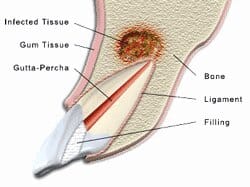
The majority of the above procedures are performed in our state-of-the-art, office-based, outpatient surgical facility. The choice of anesthesia depends on many factors. All patients are given a local anesthetic to numb the area. Patients may elect to supplement their procedure with nitrous oxide (laughing gas), intravenous sedation, or general anesthesia. Certain conditions may require your surgery to take place in the hospital. Please refer to the section on anesthesia services for a more thorough explanation of your choices.
When is a root canal necessary?
A root canal is necessary when the infection has reached the interior chamber of the tooth. This is the inner tooth where you’ll find the pulp, blood vessels, and nerves. Typically, when decay works its way through the enamel and dentin layers and enters the inner tooth, you’ll know — the infection will cause serious pain in the nerve fibers inside the tooth.
The only way to remove the bacteria inside the tooth is through a root canal. There isn’t any other method of stemming the infection. If you leave it in place, your pain will increase, and the infection will likely spread into the nearby gum tissue. From there it can spread throughout the body, even to your heart. Now the tooth will need an extraction, or it will fall out on its own.
A root canal with Dr. Sultan avoids all of that pain and you can keep the tooth, often for the remainder of your life. There is absolutely no reason to avoid a root canal, despite the wives’ tales out there about their excruciating pain. The reality is that a root canal doesn’t involve any more pain than having a filling placed in a tooth.
How long does a root canal typically take?
The average root can with Dr. Sultan takes between 30 and 60 minutes. More complex situations can take up to 90 minutes. In most cases, a crown needs to be placed over the tooth after the root canal. This requires a brief second appointment to place the custom crown.
Hear What Dr. Sultan's Patients Have To Say
"From the moment I came to this office everyone was very welcoming. I was very comfortable and Dr. Sultan was excellent. He explained everything to me ahead of time. I had all four of my wisdom teeth removed and it was a piece of cake!! Very happy with how everything turned out. Thank you to everyone who helped me!"
"Everything Dr. Sultan and the nurses and staff did at Sultan Center made my wisdom teeth surgery go so well. I was nervous, but they all did a great job at making me feel better about everything. I wouldn't change anything if I had to do it again and I would recommend them to anyone!"
Schedule Your Consultation Today
If you're interested in learning more about impacted teeth and root canals please contact us for a consultation at (954) 771-8772 or fill out our contact us form. We will discuss your needs and concerns, and determine your best course of action.
Wisdom Teeth Presentation
To provide you with a better understanding of dental implants, we have provided the following multimedia presentation. Many common questions pertaining to dental implants are discussed.
Having trouble? Please make sure you have version 9 of the Flash browser plugin in order to correctly view this presentation. This software is available as a free download.

